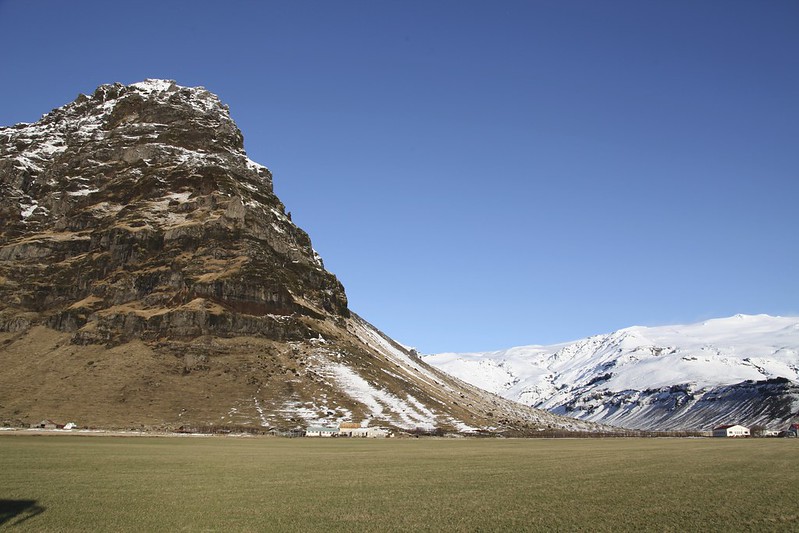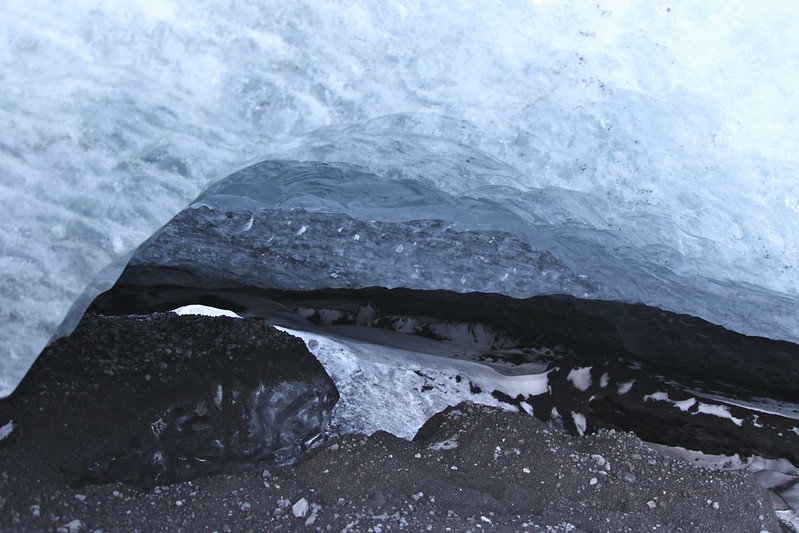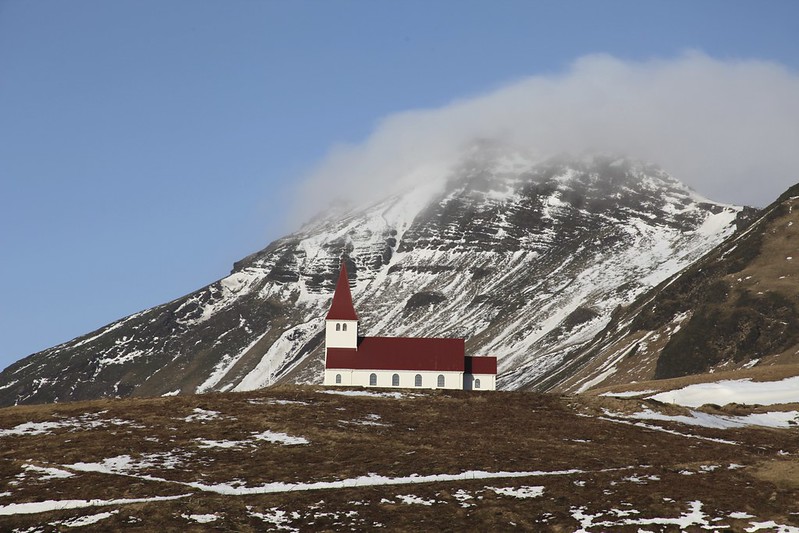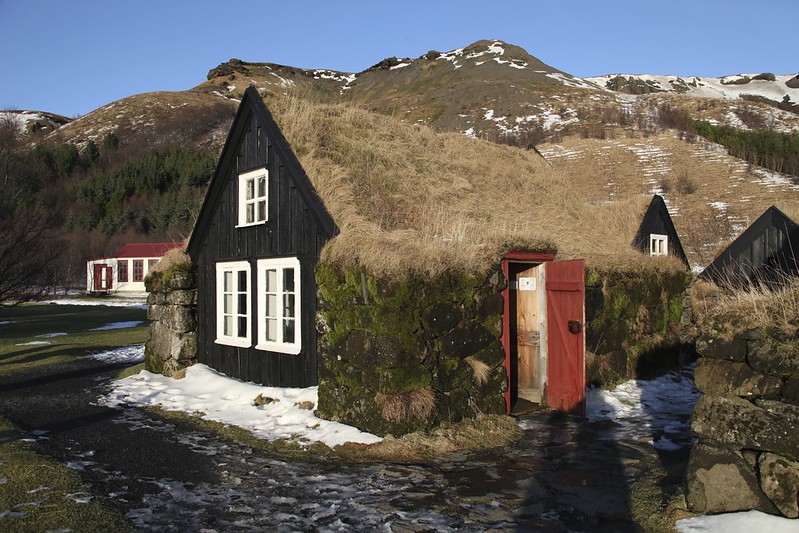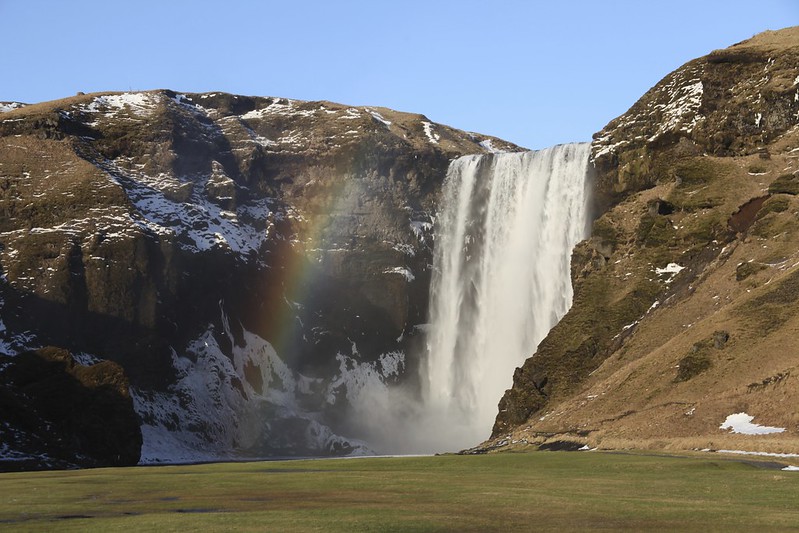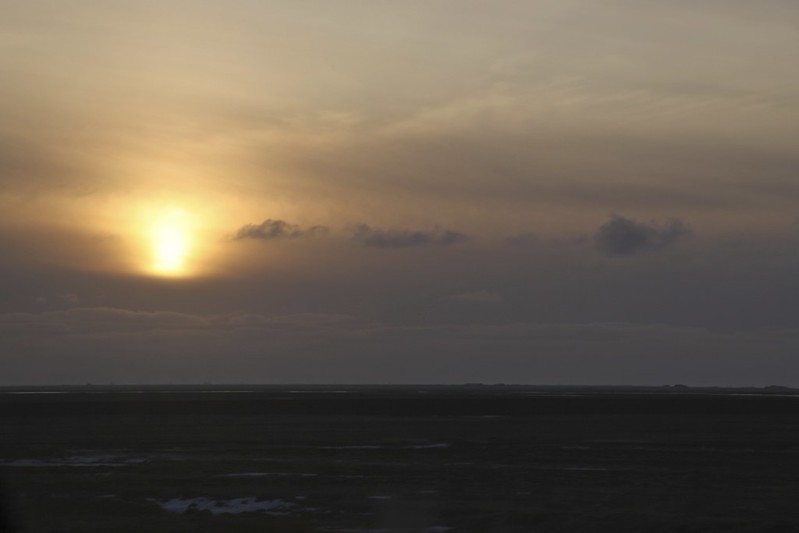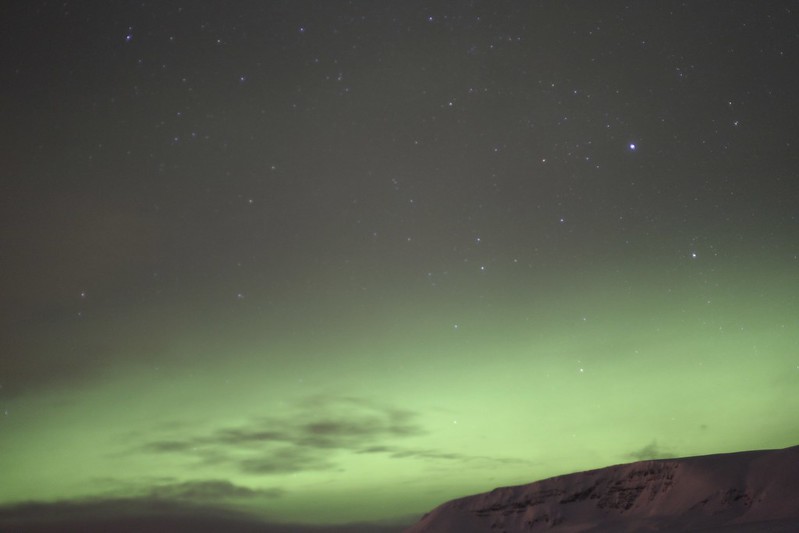Another 07:30 start, but this time with considerably more sleep. The breakfast was identical to the day before so they don’t really offer much in the way of variation. For this day’s travelling we were doing the “South Shore Adventure”. The journey was far than the previous day, but the weather had improved massively which was nice.
After about 1hr30 we stopped at a place that was little more than a petrol station and a supermarket where we bought food for the evening meal. By this time the sunrise had finished and the day looked a vast improvement over the day before. Apparently on Iceland’s shortest day (around 27th December) the Sun can rise around 11:00 and then set around 16:00 – very short days but they are further North (just outside the Arctic circle). At the time we were there the Sun would finish rising around 09:00 and set around 17:00.
About 30 minutes later we stopped to take photos of Eyjafjallajökull (which translates to English as island mountain glacier), the volcano that caused chaos with flights around Europe in 2010. You can’t really see much of it though as the ice cap pretty much covers the entire caldera. There is a pile of ash at a viewing point in front of a farm, and they did actually say if you have a bag on you, you could take some ash with you should you so wish. When the volcano last went off it didn’t affect Iceland’s internal air traffic due to the wind direction and it’s closeness to the south coast. What it did effect though was the surrounding farmlands which were covered with ash. The farmers feared that they would never be able to farm their land again and many were on the verge of moving.
Fortunately enough of the ash eventually blew away to allow crops to be planted. For the first year after the eruption the farmers were able to harvest an increased number of crops per field due to the ash acting as a fertiliser – ash being rich in minerals.
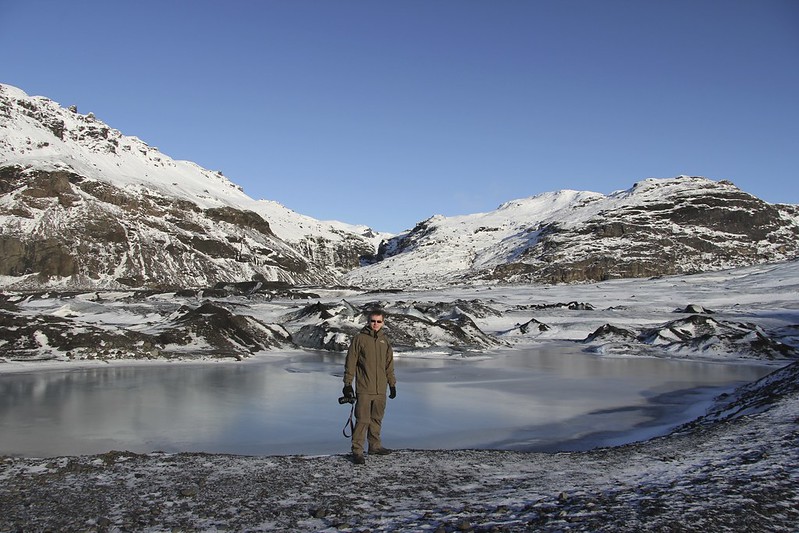 Further down the road we stopped to drop off those going on the ice walk, and took the opportunity to get close to the glaciers. The path to the Mýrdalsjökull glacier was a slow one due to it being thick with snow and ice. The path for walking to the glacier wasn’t much better either – even in walking boots it was extremely slippery. The sight of the massive blocks of ice that formed the glacier were amazing and made the effort worthwhile.
Further down the road we stopped to drop off those going on the ice walk, and took the opportunity to get close to the glaciers. The path to the Mýrdalsjökull glacier was a slow one due to it being thick with snow and ice. The path for walking to the glacier wasn’t much better either – even in walking boots it was extremely slippery. The sight of the massive blocks of ice that formed the glacier were amazing and made the effort worthwhile.
It’s hard to describe how impressive the blocks of ice were, but they were big enough in some areas to have space underneath them to crouch. You do have to watch your step here though, although in some places the snow looks like it’s level you may find yourself knee high in snow or putting your foot through some thin ice into pools of water.
Once we’d finished exploring the glacier, we left the people ice walking behind and continued on to the Eastern most point of our journey. This stop was at a place called Halsanefshellir from which you can see Reynisfjara. The beach itself is dark with all the ash that has run down to the coast along with the sand. The waves there can be incredibly high and are very unpredictable, it is here where you can see the reason that they don’t have any fishing ports or harbours around this area as the sea is far too rough which makes it dangerous.
The rock formations of Halsanefs hellir are quite impressive and are reminiscent of the rock formations known as the Giant’s Causeway in Ireland. We were told not to get too close to the rock face though as apparently there was a danger of rocks falling.
This area had an abundance of sea gulls – the only wildlife I saw in the entire trip. Apparently in the later months, they often see Atlantic Puffins (Fratercula arctica). In fact, Iceland is home to the largest number of Atlantic Puffins with around 10 million individuals. Unfortunately during the winter months this is not something you get to see.
From there we headed back to Vík í Mýrdal where we stopped for about an hour to have dinner. The food at “Strondin” was cheap, but was very limited in choice and was soaked in grease. The biggest downside to this was though that we had a 30-40 minute wait for food after ordering a BBQ burger with fries. This didn’t really leave any time for looking round due to the slow service. Next to the food place there is also a souvenir shop that also sells a lot of woollen products.
After this we started our journey back towards Mýrdalsjökull to pick up the ones we’d left to do ice walking. On the way though the coach dropped us of in Skógar at the Skógasafn (Skógar Folk Museum) whilst it headed to the glacier to pick up the others. Whilst we were at the museum we were shown around and told about Iceland’s history by it’s founder Þórður Tómasson, and his daughter. They are both very enthusiastic about the history of Iceland and this does easily come across in their fantastic tour of the museum.
Inside the museum the most obvious attraction is the large Pétursey fishing boat, though they also have many tools, books, furniture and examples of traditional clothing. Outside of the museum there are numerous buildings that have been relocated from elsewhere to preserve the style of Icelandic building. Amongst these examples are turf houses, a church which is a collection of parts from other churches – such as the majority of the interior that came from Kálfholt Church, built in 1879. There is also a schoolhouse that was formerly the elementary school at Litli-Hvammur, Mýrdalur and was built in 1901.
During this trip we also saw two large waterfalls – the first of these was Skógafoss, a waterfall fed from the Skógar river. When we were there it was possible to see a rainbow due to the amount of mist that drifted in front of the waterfall. This is apparently one of the highest waterfalls in Iceland and is situated at what was once the coastline of the island, but is now about 5km from the new coast.
The second, not quite so powerful waterfall we saw was Seljalandsfoss. Although it may not be as powerful as the previous that does not stop it from being particularly picturesque. This waterfall is fed from the Seljalandsá river and is once again a waterfall from what was previously the coast. This one does have the advantage that you can walk round behind the waterfall to get some interesting views, though sadly on the day we were there the paths were frozen and impassable due to the previous day’s weather.
As we headed back to Reykjavik we were treated to an impressive sunset, but at the same time the perfectly clear day was coming to and end with it clouding over. This did make us question whether seeing the Aurora Borealis would be possible, but towards the end of the journey it was confirmed that the Northern Lights tour would be on. We got back to the hotel for just after 19:00 which gave us a couple of hours until we had to be heading back out to see the lights. This gave us just enough time to eat the food we’d picked up earlier, get camera equipment ready and to change into warmer clothes. We also had to confirm with reception we still wanted the return shuttle bus journey the following morning to get back to the airport. Something we almost forgot to do.
When the Reykjavik Excursions coach turned up it then took us as normal to the hub where we dropped a few off to change to one of the many other coaches that were preparing to go out. It was then around a 30 minute drive out of Reykjavik to an area that was not so affected by light pollution so that we would be able to see the stars, and more importantly the Northern Lights. On the way the guide explained that people should not bother using flashlights or camera flashes as it will not make any difference when trying to take a picture – a pretty obvious thing, and we’d prepared by getting red lights beforehand as they preserve your night vision when used.
Along the journey the Northern Lights were eventually pointed out to us, and they were far from what we expected. We were told they could be seen out the left-hand side of the bus but all I could see where these wispy clouds in the night sky. Eventually it was explained that those “clouds” were in fact the Northern Lights. Very different from the colourful lights I was expecting! Eventually we pulled off the road and the coach turned off all it’s lights so we could allow our eyes to adjust to the night sky. Sadly this didn’t really help as several more coaches turned up with their lights on initially, and even then people were ignoring the advice and attempting to use their flashes to take pictures of the lights.
The session lasted for around 1hr30, all this time we were continuously shooting photos at different settings, all at around f/1.4 but with varying ISO and exposure times. To get some variation we took shots at different places and had to move our tripods forwards a few times to try and reduce the effects of people using flashes. Through the camera we could seen the green hue we’d been expecting so we were pleased we’d got to see what we’d hoped. Admittedly most of my photos didn’t come out great, but it made for a good learning experience and was enjoyable.
As time got on it did get colder which made us grateful we’d planned ahead with warm clothing and hand warmers. One thing of note though is that it would have been better to get the hand warmers warming up about 30 minutes before we needed them as the chemical reaction in the pockets can be slow to get going and start producing heat. Amazingly though the following morning there was still some heat left in the one I’d used during the lights.
As the light show finally came to and end the coach turned it’s lights on to indicate it was getting ready to go pretty much straight away. Neither of us had time to pack our tripods away properly before the bus got moving. Not particularly considerate of them but they did turn the lights back on when my friend moaned about them. By the time we got back to the hotel it was 11:20, so we spent the next 20 minutes getting suitcases repacked ready for the 05:00 start.

